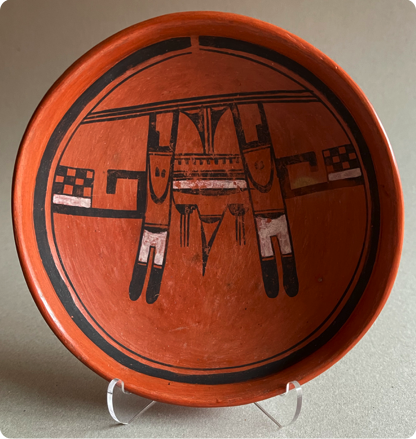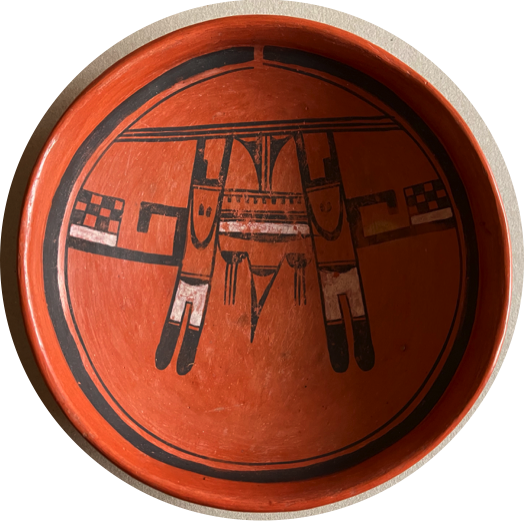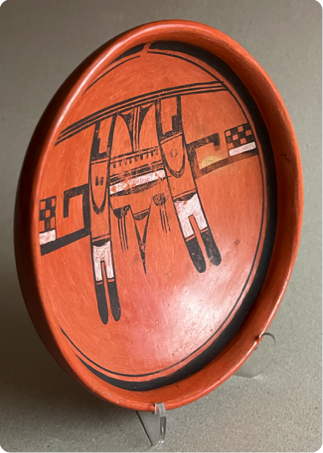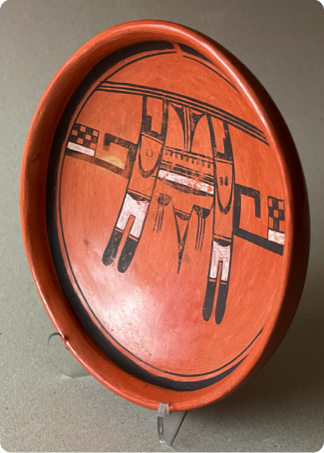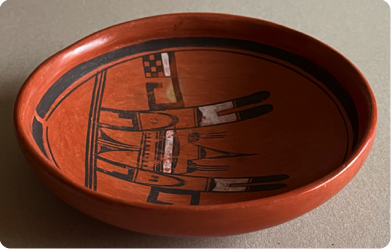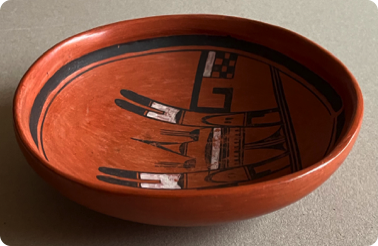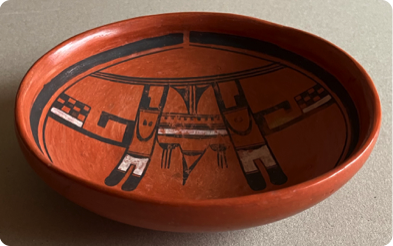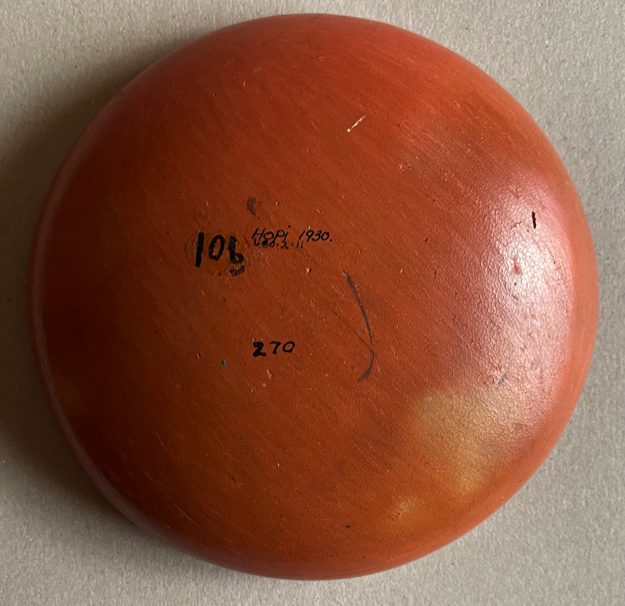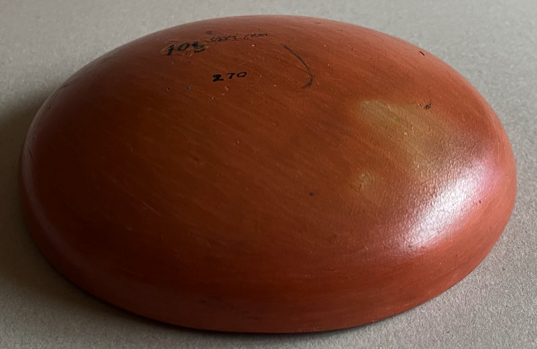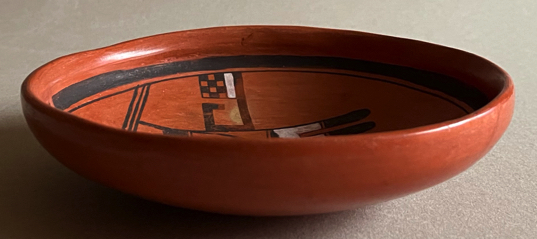
© 2010-2024 by Fine Arts of the Southwest, Inc. All rights reserved.
Unauthorized reproduction or use is strictly prohibited by law.
A rare and striking historic Hopi “Red Polychrome” pottery bowl by Nampeyo, c. 1900-1905
In the closing years of the 19th Century beginning around 1898, the renowned Hopi potter, Nampeyo (1859-1942) artistically revived and re-interpreted several ancient forms of ancestral Hopi and related area pottery some of which are variously referred to today as Bidahochi Polychrome, Homolovi Polychrome, Four Mile and Show Low Polychrome.
All of these pottery types are named after the respective prehistoric villages where they were produced which have all been in ruins for centuries in and around the general area of the Hopi mesas in northern and central Arizona.
In appearance, these pottery types are all characterized by the visually striking use of a thick, bright white Kaolin
paint outlining around darker design areas or against darker colored backgrounds of red, orange, yellow and brown.
At left, Homolovi Polychrome jar, c. 1375 A.D. At right, Bidahochi Polychrome bowl, c. 1400 A.D.
Right photo source and © Icollector
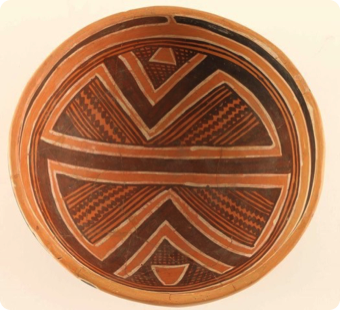
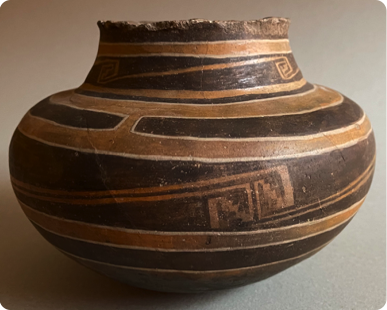
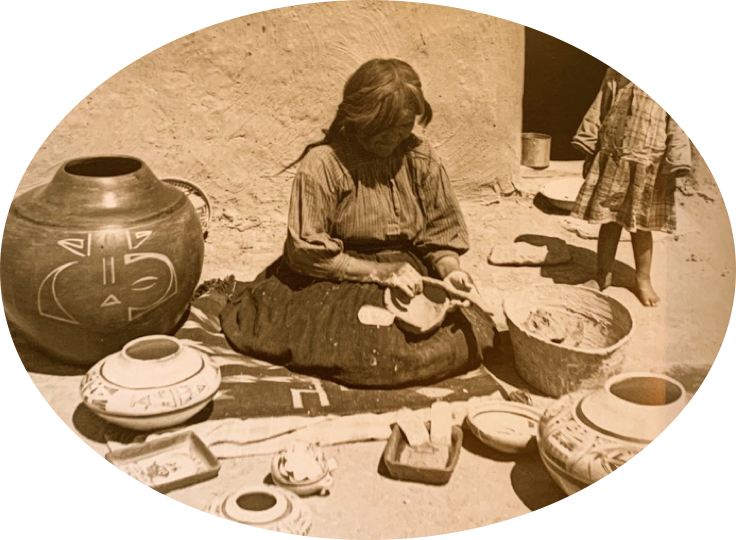
Note the large "Red Polychrome" type jar to Nampeyo's right in this historic photograph entitled, “Mrs. Nampeyo,
an acknowledged best Hopi Indian woman Pottery maker, 1st Mesa, Hopiland, Ariz. Sichomovi” by R. Raffius, 1905.
Left photo source and © Keystone-Mast Collection, UCR/California Museum of Photography, University of California, Riverside. Right photo source and © Milwaukee Museum
"Nampeyo makes her designs after some she has seen on ancient ware."
-Hopi Ethnologist Alexander M. Stephen, 1893
In all, this bowl is in fairly remarkable original condition for a 120-125 year old fragile pottery vessel from a remote and difficult to travel around region particularly back in the 1905 era. Most likely, this bowl was originally purchased at Hopi either from Nampeyo herself or from a nearby Hopi trading post such as Thomas Varker Keam's or J.L. Hubbell's. It could also have possibly been purchased at the famous Fred Harvey Company's Hopi House facility on the South RIm of the Grand Canyon where Nampeyo and her family maintained a summer residence and gave regular pottery making demonstrations around the time frame this bowl was made, 1900-1905. In any case, the small size of the bowl made it easier to pack and transport back to the purchaser's home, likely traveling on the Santa Fe Railway in the common way for visitors to get to and from the Hopi villages in the early 20th Century.
This bowl is both a beautiful compilation and a precise and eloquent intersection of artistic beauty
and historic and cultural expression, integrity and preservation. It is a lovely and satisfying object
and an enduring legacy to ponder and enjoy.
Price $2,450
Nampeyo continued making Red Polychrome vessels until around 1915-25 assisted in the later part of this time frame by her eldest daughter Annie, but for a number of specific reasons we believe this bowl is a complete product of Nampeyo’s own skilled hands. First, is the form and potting of the vessel. Nampeyo liked to use an extra coil of clay just under the rim of her bowls which gives the piece a pleasing contour and this bowl has that. The vessel walls are thin and hight-fired using high temperature Lignite coal from the Hopi Antelope Mesa, a painstakingly difficult ancient pottery-making technique which Nampeyo also revived and mastered. Too, the vessel is perfectly stone polished all the way around to a fine soft satiny sheen, another Nampeyo telltale. And all that leads to the wonderful striking abstracted bird’s tail and feather design. This is Nampeyo’s own personal interpretation and presentation of certain
of the similar ancient designs found on Hopi Sikyatki-Period pottery vessels (1375-1625 A.D.) as well as on the ancient Hopi kiva murals in the ruined ancient Hopi villages of Awatovi and Kawaiika-a on Antelope Mesa.
The bowl measures just over 6” in diameter, exactly 6 1/8", and it is 1 1/2" in height. It is in generally excellent original condition with some degree of abrasion wear to the bowl’s interior. There are no cracks and no chips and a thorough examination of the bowl under Ultraviolet light reveals no restoration or overpainting in evidence anywhere. There
are some unknown collection type numbers written in black ink on the bottom of the bowl as well as the chronologically inaccurate description "Hopi 1930".
